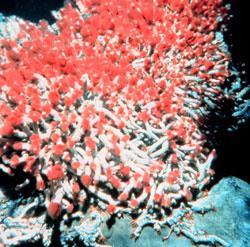Snapshot of the proteins that make life possible next to volcanic vents.
While we trudge to the supermarket suffering the wild winter weather, certain deep-sea residents manage to survive their searingly hot, toxic habitat by making their own food. Chemists in the US have now identified the molecules that make this possible.
The Riftia tubeworm makes its home next to hydrothermal vents - living at temperatures ranging from freezing to a volcanic 400 degrees Celsius, and managing without a digestive system. Stephanie Markert from the Institute of Marine Biotechnology in Greifswald, Germany and her colleagues, have now provided biologists with a unique insight into the tubeworms’ secret. They have distinguished and studied the activity of proteins that make food for this plucky creature.
With no mouth or digestive system, the Riftia worm relies on symbiotic organisms for nutrition. These symbionts live within the worm, in an organ called a trophosome. They use the compounds in the toxic sulfurous mixture spewed out of hydrothermal vents to make organic carbon as a food source for their host. This unusual method of food production is known as chemoautotrophic symbiosis.

Markert’s group took a proteomic approach, using samples of tubeworm trophosome and separating them into their constituent proteins using gel electrophoresis. This uncovered carbon-fixing enzymes, which power the conversion of vent chemicals into worm food.
The results showed just how efficient symbionts are at feeding their host. The team discovered enzymes involved in two separate metabolic pathways, allowing the organisms to adapt their food production method to the elements and energy available in their environment.
Peter Girguis from Harvard University in the US is a biologist who studies hydrothermal vents. He told Chemistry World that without these new protein profiles scientists may never have considered looking for these particular enzymes, leaving a big gap in the knowledge of this extraordinary metabolism.
’These symbionts appear very well poised for oxidizing a lot of sulfide and using the energy generated from that process to fix a lot of carbon,’ Girguis told Chemistry World. ’It seems that the symbionts have something of a "cushy" lifestyle. The worm does all the work of providing substrates and buffering environmental changes that enable these symbionts to really crank out organic [compounds].’
Girguis commended Markert’s question-driven approach in adapting existing technology to answer fundamental questions about biological systems. Research into tubeworm metabolism has previously been hampered by the fact that no chemoautotrophic symbiont has ever been cultured in the laboratory.
Now that these enzymes have been identified, Girguis foresees their potential beyond the worm’s struggle to survive. ’I think commercial applications will benefit from studies like these. They help industrial scientists consider new and innovative uses of technologies they’ve already developed in addition to looking for novel enzymes for industrial applications,’ he said.
Victoria Gill
References
et al, 2007, 315, 247






No comments yet